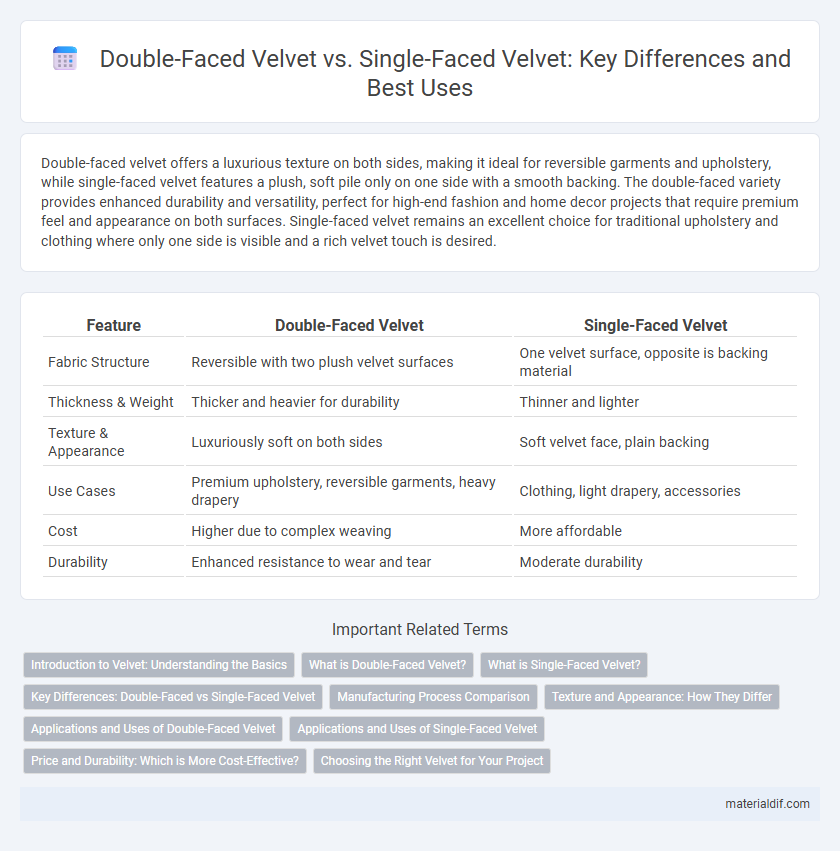Double-faced velvet offers a luxurious texture on both sides, making it ideal for reversible garments and upholstery, while single-faced velvet features a plush, soft pile only on one side with a smooth backing. The double-faced variety provides enhanced durability and versatility, perfect for high-end fashion and home decor projects that require premium feel and appearance on both surfaces. Single-faced velvet remains an excellent choice for traditional upholstery and clothing where only one side is visible and a rich velvet touch is desired.
Table of Comparison
| Feature | Double-Faced Velvet | Single-Faced Velvet |
|---|---|---|
| Fabric Structure | Reversible with two plush velvet surfaces | One velvet surface, opposite is backing material |
| Thickness & Weight | Thicker and heavier for durability | Thinner and lighter |
| Texture & Appearance | Luxuriously soft on both sides | Soft velvet face, plain backing |
| Use Cases | Premium upholstery, reversible garments, heavy drapery | Clothing, light drapery, accessories |
| Cost | Higher due to complex weaving | More affordable |
| Durability | Enhanced resistance to wear and tear | Moderate durability |
Introduction to Velvet: Understanding the Basics
Double-faced velvet features a luxurious pile on both sides, providing reversible softness and enhanced durability, while single-faced velvet has a plush pile only on one side with a backing on the other. The structural difference affects their applications, with double-faced velvet favored for high-end upholstery and garments where both sides may be visible. Understanding these textile variations is essential for selecting the right velvet type for specific design and functional needs.
What is Double-Faced Velvet?
Double-faced velvet is a luxurious fabric featuring two distinct, plush surfaces on both sides, unlike single-faced velvet which has a pile only on one side. This unique construction provides enhanced durability and a reversible aesthetic, making it ideal for upholstery, fashion, and home decor. The double-sided pile offers a richer texture and greater flexibility in design applications compared to standard single-faced velvet.
What is Single-Faced Velvet?
Single-faced velvet features a plush, dense pile on one side while the backside remains smooth and flat, offering a more lightweight and flexible fabric option compared to double-faced velvet. It is commonly used in apparel and accessories where only one luxurious, soft surface is desired. This type of velvet prioritizes aesthetic appeal on the visible side while maintaining cost-effectiveness and ease of sewing.
Key Differences: Double-Faced vs Single-Faced Velvet
Double-faced velvet features equal softness and texture on both sides, making it reversible and ideal for upholstery and garments where both sides are visible, whereas single-faced velvet has a plush, smooth surface on one side and a plain backing on the other, suited for applications requiring only one decorative side. The construction of double-faced velvet involves weaving two separate fabrics together, doubling the fabric's weight and durability, while single-faced velvet consists of a single layer with the pile on top. These differences affect cost, weight, and usability, with double-faced velvet typically being heavier, more expensive, and preferred for luxury items compared to the lighter, more economical single-faced velvet.
Manufacturing Process Comparison
Double-faced velvet is produced by weaving two layers of velvet fabric simultaneously and then cutting them apart to create two separate pieces, resulting in a fabric with pile on both sides and increased thickness. Single-faced velvet, in contrast, is woven with only one pile side and a plain backing, making the manufacturing process simpler and less time-consuming. The double-faced method requires specialized looms and more material, impacting production costs and fabric durability.
Texture and Appearance: How They Differ
Double-faced velvet features a plush, soft texture on both sides, offering reversible use and a luxurious, symmetrical appearance, while single-faced velvet has a smooth, soft pile only on the front side with a flat backing. The double-faced velvet's dense weave results in a thicker, more substantial fabric with enhanced durability, contrasting with the lighter, more delicate feel of single-faced velvet. Visually, double-faced velvet presents a richer, more uniform look, whereas single-faced velvet displays a sheen and texture difference between the front and back surfaces.
Applications and Uses of Double-Faced Velvet
Double-faced velvet offers versatility in applications such as luxury upholstery, high-end fashion, and elegant home decor due to its smooth, equally soft texture on both sides. It is ideal for reversible clothing, drapery, and accessories where both sides are visible, enhancing aesthetic appeal and functionality. This type of velvet is favored in upholstery projects requiring durability and beauty, providing a richer, more luxurious finish compared to single-faced velvet.
Applications and Uses of Single-Faced Velvet
Single-faced velvet features a plush pile on one side and a smooth backing on the other, making it ideal for applications requiring softness and visual luxury without bulk, such as upholstery, drapery, and fashion garments like dresses and blouses. Its lightweight nature and elegant texture enhance home decor projects and apparel that benefit from a rich appearance with easier handling and reduced cost compared to double-faced velvet. Single-faced velvet is preferred in creating linings, cushions, and accessories where only one surface needs to exhibit the characteristic velvet sheen and feel.
Price and Durability: Which is More Cost-Effective?
Double-faced velvet offers greater durability due to its two-sided construction, making it more resilient for high-traffic areas compared to single-faced velvet. Although double-faced velvet is generally priced higher upfront, its extended lifespan often results in better long-term cost-effectiveness. Single-faced velvet, being less expensive initially, may require more frequent replacement or care, increasing overall expenses over time.
Choosing the Right Velvet for Your Project
Double-faced velvet features plush texture on both sides, offering versatility and enhanced durability ideal for upholstery and reversible designs. Single-faced velvet has a soft, luxurious pile on one side with a smooth backing, making it lightweight and suitable for garments or drapery where only one side will be visible. Selecting the right velvet depends on project requirements for appearance, durability, and fabric weight to ensure optimal performance and aesthetic appeal.
Double-Faced Velvet vs Single-Faced Velvet Infographic

 materialdif.com
materialdif.com